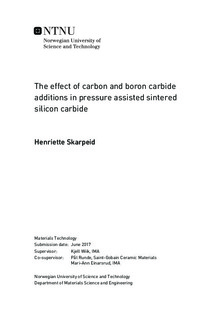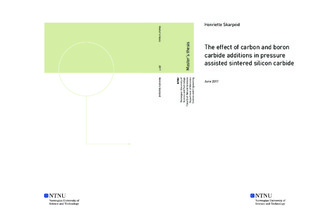| dc.description.abstract | Silicon carbide is a highly covalent ceramic, so additives like carbon and boron must be present in order to obtain a dense material during sintering. The focus of this project is to investigate how the amount of carbon and boron carbide added effects the density, phase composition and mechanical properties of pressure-sintered silicon carbide. Three different commercial SiC-powders, Densitec 13H (13 m2/g), Densitec 15H (15 m2/g) and Densitec 13HR (13 m2/g) were tested with different amounts of carbon, ranging from 0-2.5 wt%. The powders were hot-pressed at 2050°C with 20 MPa pressure for one hour. Densitec 13HR was also tested with boron carbide content from 0.2-1.7 wt%. These powders were spark plasma sintered at 2050 °C with 20 MPa pressure for 10 minutes. All samples were then polished and characterised.
Densitec 13H obtained higher density for lower carbon concentration than Densitec 15H, while Densitec 15H had the higher density when the amount of carbon exceed 1.0 wt%. The hardness measured with Vickers micro-indentation showed a similar trend. Both samples achieved densities above 98.5 % with no carbon addition, and a hardness of approximately 2750 HV. In Densitec 13H, the specific surface area is smaller than in Densitec 15H. Therefore, less carbon is consumed during sintering, and will have more carbon present on the grain boundaries, which will decrease the density and hardness.
Densitec 13H, which contains carbon black, was further compared to Densitec 13HR, with resin as carbon source. Both density and hardness measurements showed very similar values regardless of the amount of carbon. Densitec 13H had more large anisotropic grains, which increased the fracture toughness. The opti- mised boron carbide content based on density and mechanical properties are 0.7 wt%, which is lower than the concentration used today (1.2 wt%). The SPS- samples had considerable grain growth during sintering. The large grains affected the mechanical properties and resulted in high hardness, but low fracture toughness. | |

